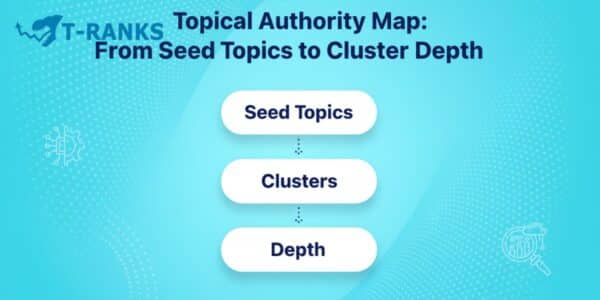Understanding how to build a Topical Authority Map is one of the most important steps in modern SEO.
It helps you organize your content in a clear structure that search engines and AI systems can easily understand.
Instead of writing random blog posts, you plan every topic around one main idea, create related clusters, and connect them with internal links that show expertise and relevance.
In this article, you’ll learn what a Topical Authority Map is, why it matters for SEO, and how to build one step-by-step using proven methods like the Koray Framework and PPR approach.
By the end, you’ll know how to create a content system that improves rankings, strengthens your site’s authority, and helps you appear in AI-powered search results.
What Is a Topical Authority Map
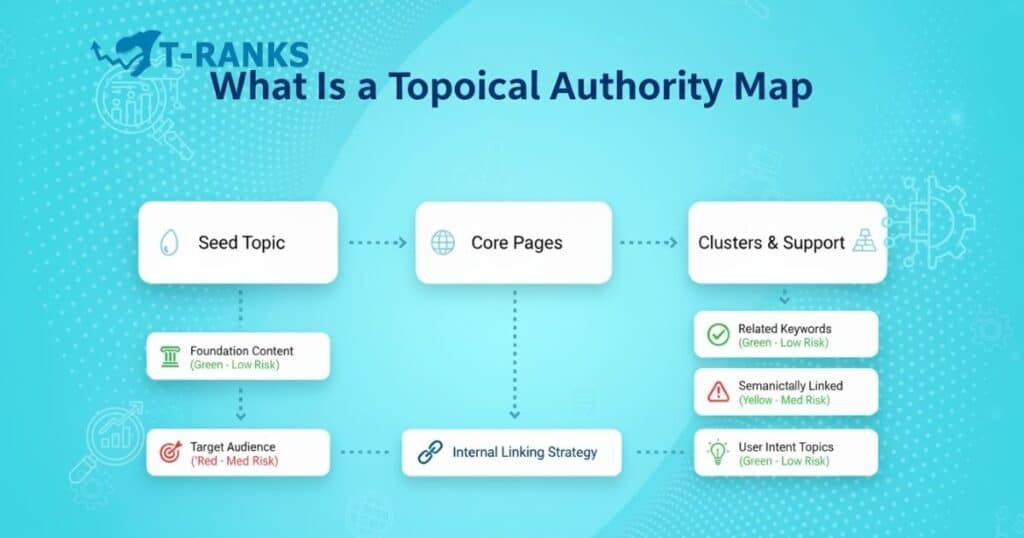
A Topical Authority Map is the structured and organized planning framework you create before launching a website or writing any content. It defines the foundation of your entire site: what topics you’ll cover, how those topics connect, and how each page contributes to building real authority in your niche.
In simple terms, it’s a map of your website’s knowledge system. Instead of guessing what to publish, you plan in advance:
• What is my main topic, also called the seed topic, that represents my brand or service?
• What are my core pages that directly define my authority and business goals?
• What are my outer or support pages that strengthen the overall structure and add topical depth?
Most people skip this step. They launch their site without a clear direction, start writing random blogs, or chase trending keywords without understanding how it all fits together. The result is a website that confuses both users and search engines — pages compete with each other, authority gets diluted, and Google never clearly understands what the site is about.
A Topical Authority Map solves that problem by helping you plan your entire content architecture before you publish anything. It brings clarity, focus, and long-term scalability.
Example
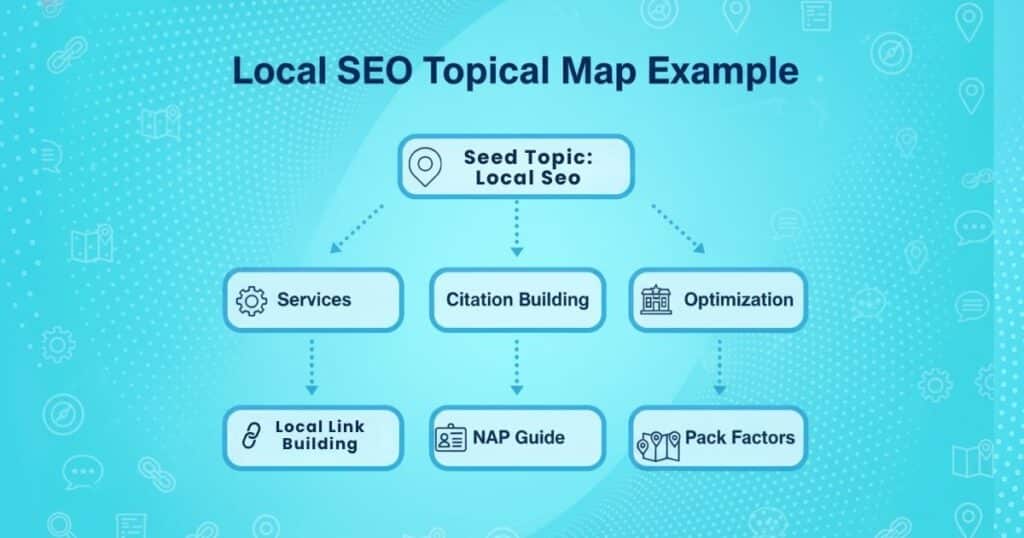
Imagine you’re launching a local digital marketing agency that wants to become known for Local SEO.
Your Topical Authority Map could look like this:
Seed Topic (Main Theme): Local SEO
Core Pages (Authority Pages): Local SEO Services, Local Citation Building, Google Business Profile Optimization. These pages directly represent your business and help you convert visitors into clients.
Cluster Pages (Supporting Depth): Local Link Building Tactics, NAP Consistency Guide, Map Pack Ranking Factors. These educate your audience and strengthen topical expertise.
Outer Pages (Peripheral Support): FAQs, glossaries, and tools like a Local SEO Audit Checklist or Citation Finder. These smaller pages reinforce the topic and interlink with your clusters and core pages.
When all these pages are connected properly, your website starts to look like a well-organized knowledge network instead of a collection of disconnected posts. Google can see your focus area, understand your expertise, and rank your content confidently across related searches.
Why Is a Topical Authority Map So Important
Topical authority is not just an SEO method, it’s the foundation of your digital identity. It defines how Google and AI systems understand what your site is truly about.
When you have a clear topical structure, every page supports the next. Search engines can follow the logical relationships between your content, while users can easily move from one question to the next without leaving your site. This kind of structured clarity builds both trust and discoverability.
Without a Topical Authority Map, even great content can fail. Many business owners create beautiful websites but never build the right content hierarchy. They cover unrelated topics, write duplicate pages, or skip important subtopics. This makes the site look scattered and weak in the eyes of Google’s algorithms.
By mapping your topics first, you align every piece of content with a clear purpose. You know exactly what to write, how deep to go, and how each page connects to your authority pillars. It also prevents wasted effort and ensures every blog post or landing page fits into a long-term strategy rather than a short-term trend.
At T-RANKS, we use the Koray Framework to design these maps for our clients. This approach organizes every site around entities, relationships, and PPR prioritization , which stands for Prominence, Popularity, and Relevance. It ensures that each page strengthens the others and builds a connected authority system that Google can easily interpret.
In essence, a Topical Authority Map gives your business a clear direction before you even start publishing. It turns random ideas into a structured plan and transforms your website into a focused, trustworthy source of expertise that keeps growing over time.
How the Koray Framework and PPR Method Shape Your Topical Map
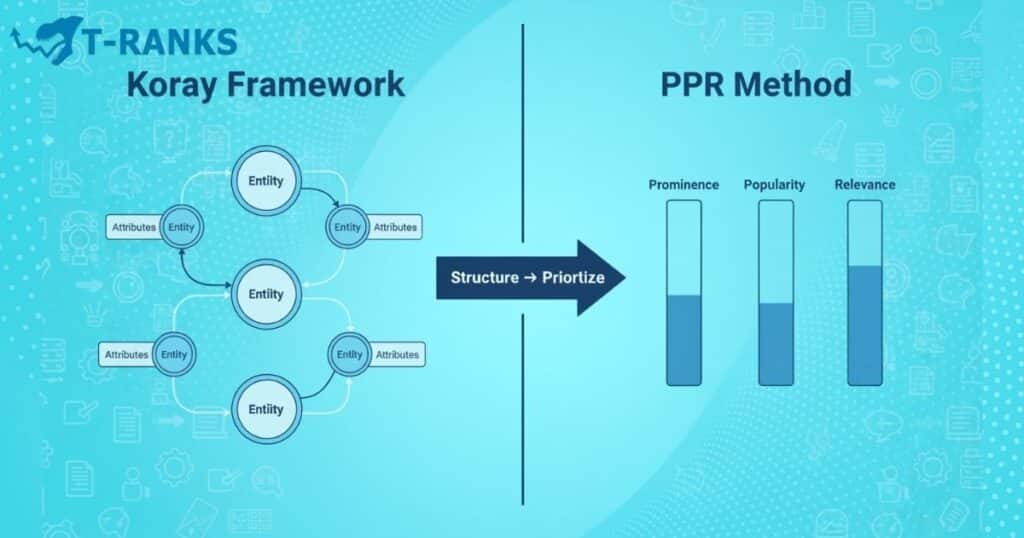
Once you understand what a Topical Authority Map is, the next step is learning how to design it effectively. That’s where the Koray Framework and the PPR Method come in. These two models work together the Koray Framework helps you structure your topics around meaning and relationships, while the PPR Method helps you decide what to publish first for maximum impact.
You don’t need to master every technical detail to use them. Think of them as a strategic lens that turns your ideas into a clear, step-by-step system Google can easily interpret.
1. The Koray Framework Building Meaning, Not Just Keywords

Most websites start with keywords; the Koray approach starts with entities. An entity is a real thing — a concept, tool, or process that can be clearly defined and connected to others. In this framework, your goal is to build a semantic structure of how these entities relate within your niche.
Here’s how to apply it in practice:
• Identify your main entities Start with the key ideas your audience needs to understand. For example, if your main topic is Technical SEO, your entities might include Core Web Vitals, Crawl Budget, and Structured Data.
• Add attributes and relationships Attributes describe the details about each entity. For Core Web Vitals, these could be LCP, CLS, and FID. Then define how one concept connects to another — for example, Core Web Vitals improve Page Experience.
• Create content around these relationships Each relationship can become a blog post, tutorial, or tool. When you publish content that reflects real-world relationships, Google sees your site as a structured web of knowledge — not a collection of disconnected articles.
Example: If your topic is Email Marketing, you might map it like this: Deliverability → depends on → Sender Reputation → improves → Campaign Performance. Each phrase becomes a page, and together they form a simple, meaningful content network.
That’s the essence of the Koray Framework — focusing on meaning and context, not just keyword targeting.
2. The PPR Method Deciding What to Publish First
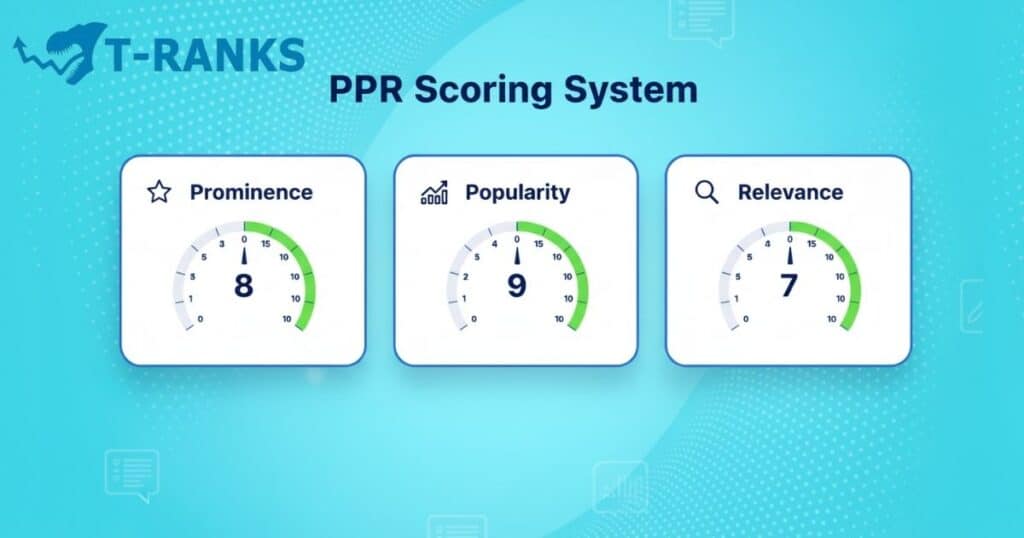
After mapping your topics using the Koray Framework, the next challenge is knowing where to start. That’s where the PPR Method (Prominence, Popularity, and Relevance) helps. It’s a simple but strategic system for prioritizing your content based on what matters most to both users and your business.
Here’s how to apply it:
• Prominence — How central is this topic to your business or niche? Write first about what directly defines your authority. For an SEO brand, “Keyword Mapping” is more prominent than “AI Copywriting Tips.”
• Popularity — How much search or community demand exists for this topic? Check search volumes, People Also Ask boxes, or Reddit discussions to identify what real users care about.
• Relevance — How closely does the topic connect to your main theme or service? If you run a SaaS SEO platform, AI SEO Audit is relevant; Blogging Trends 2026 is not.
You can score each topic out of 10 for these three factors. The higher the total, the sooner you should create that page. This method ensures you build topical authority in a logical sequence — starting from your core themes and expanding outward.
3. Bringing It Together
When you combine both systems, you move from theory to a practical SEO workflow:
- The Koray Framework gives you the structure how your topics connect and what relationships exist.
- The PPR Method gives you the order what to create and prioritize first for maximum impact.
Together, they turn your content plan into a living, connected ecosystem that Google’s systems can easily read and reward. You’re no longer writing random posts, you’re building a semantic architecture that grows authority naturally, one page at a time.
From Seed Topics to Cluster Depth (5 Practical Steps)
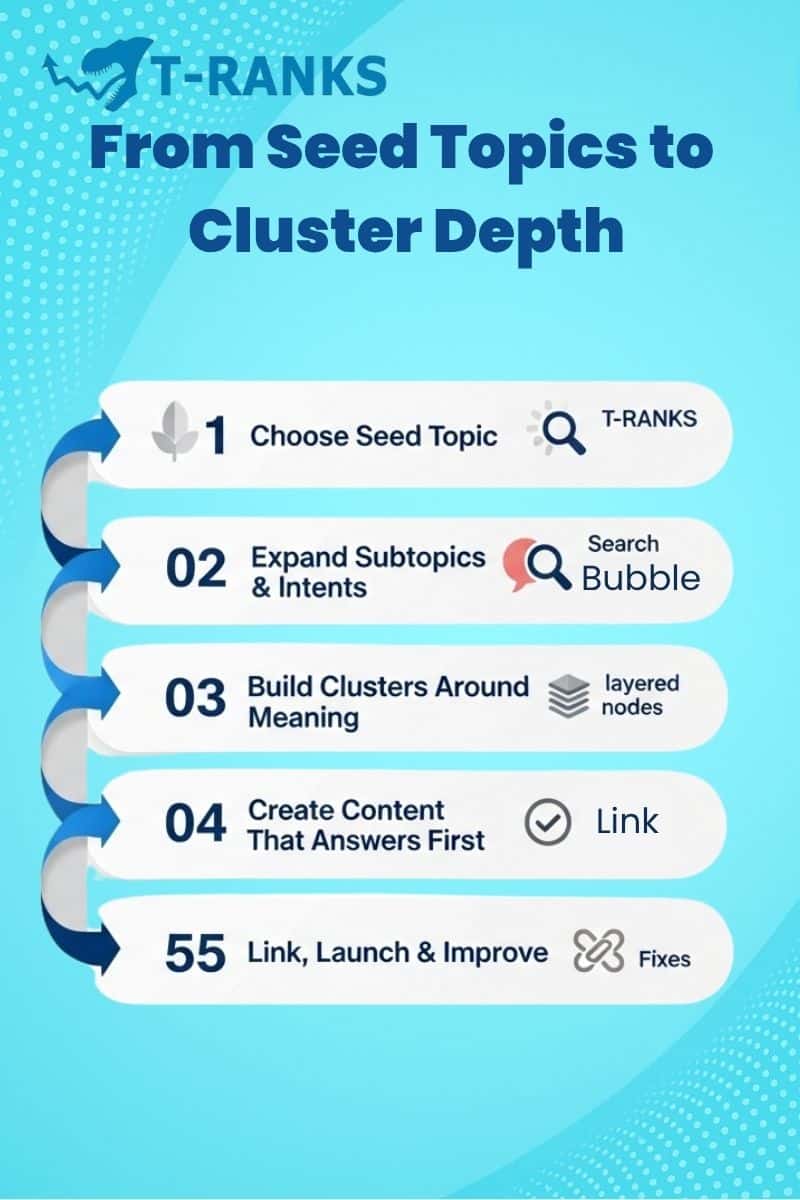
Building a Topical Authority Map is how you turn your website from a collection of random blog posts into a connected, topic-driven ecosystem that search engines trust.
Instead of writing whatever sounds good this week, you follow a clear roadmap — from one main idea to a network of content that builds authority step by step.
Step 1: Choose Your Seed Topic
Your seed topic is the main subject you want your business to be known for — the foundation of your entire content strategy.
It should sit at the intersection of your product, your audience’s needs, and search opportunities.
Example:
RankGrow is an SEO software brand. Instead of trying to cover every SEO topic, they start with Keyword Research. It’s something their tool solves directly, it has high search demand, and it aligns perfectly with what their users want to learn.
Pro Tip: Focus on 1–3 seed topics. Go deep, not wide.
You’re building expertise — not chasing every trending keyword.
Step 2: Expand Subtopics and User Intents
Once you’ve picked your seed topic, it’s time to dig deeper.
You want to understand all the ways people search for and think about that topic — from beginner questions to buying decisions.
Start by exploring user intents:
- Informational: People want to learn — “What is keyword research?”
- Commercial: People compare options — “Best keyword research tools.”
- Transactional: People are ready to act — “Buy keyword tool for SEO.”
- Niche or Contextual: People need specifics — “Keyword research for YouTube.”
Use tools like People Also Ask, Reddit, and competitor blogs to gather real questions users ask.
These insights form the foundation of your subtopics.
Example:
RankGrow found that users often ask about free keyword tools, how to analyze long-tail keywords, and how to map topics using AI — all natural subtopics under the main seed topic.
Step 3: Build Clusters Around Meaning
Next, group related subtopics into clusters— sets of pages that explore one main idea from multiple angles.
Each cluster supports your pillar page, and all clusters connect together to build depth.
Example:
For the seed topic Keyword Research,”RankGrow creates three clusters:
- The Basics Cluster – covers “What is keyword research,” beginner guides, and FAQs.
- The Tools Cluster– compares keyword tools, reviews features, and shows tutorials.
- The Advanced Cluster– dives into semantic SEO, keyword mapping, and AI-powered research.
Each cluster includes 4–6 pages, all linking back to the main pillar page. The Complete Guide to Keyword Research.”
Step 4: Create Content That Answers First
When writing each page, start with the answer.
Don’t make readers scroll forever to find what they came for. Give them the solution first — then explain the “how” and “why.” This structure helps people (and Google) quickly understand your content, improving your chances of ranking in Featured Snippets and AI Overviews.
Example:
For the article ,”What Is Keyword Research?”, RankGrow begins with:
“Keyword research is the process of finding and analyzing the search terms people use on Google so you can create content that matches what your audience wants.” Then they expand into the steps, tools, and real examples, adding visuals and tips along the way. That one simple structure — Answer → Explain → Expand— turns every page into something both user-friendly and AI-readable.
Step 5: Link, Launch, and Improve
Once your content is live, connect it. Your internal links are what tell Google how your pages relate — and which ones hold the most authority. Every cluster article should link back to the pillar page, and related clusters should link to each other naturally.
This builds strong semantic bridges that help both readers and search engines navigate your topic with ease.
Then, track your performance using Google Search Console and Ahrefs:
* Which pages are growing fastest?
* Which ones need updates?
* Where are people dropping off?
Update your clusters every few months — add new data, improve internal links, and refresh examples.
Example:
When RankGrow saw that their “Free Keyword Tools” article was getting more clicks than expected, they added new comparisons, linked it to related posts, and turned it into a small hub of its own.
That single update boosted the entire “Tools Cluster” performance by 30%.

Understanding Pillar, Cluster and Support Pages

Every strong Topical Authority Map is built on three types of content: Pillar pages, Cluster pages, and Support pages.
Each one plays a unique role in shaping your website’s structure and helps search engines and readers clearly understand how your topics connect.
You can think of them as the foundation of your content system — each level supports the other and strengthens your overall authority.
Pillar Pages
A pillar page is your main hub of authority. It introduces a broad topic and connects all related articles under one roof.
It offers a complete overview and links out to detailed pages that explain each part in depth.
Why it matters:
Pillar pages show Google what your website is truly about. They target broad, high-value topics and pass link equity to smaller, related pages, strengthening your entire cluster.
Example:
A marketing agency might have a pillar page titled The Complete Guide to Local SEO.
It explains what Local SEO is, why it matters, and outlines strategies for citations, reviews, and business listings while linking to detailed pages like Google Business Profile Optimization or NAP Consistency Guide.
Cluster Pages
Cluster pages give depth to your topic. Each one explores a single question, process, or method in detail and connects back to your main pillar.
They represent the practical side of your authority — the pages that answer specific search intents like “how,” “why,” or “which.”
Why it matters:
Cluster pages help your site cover a topic completely. They capture long-tail keywords, support semantic depth, and make your content system easy for Google to navigate.
Example:
For a health website with a pillar page on Healthy Eating, cluster pages might include Meal Planning for Beginners, Understanding Macronutrients, and Best High-Fiber Foods.
Each page focuses on one topic but connects naturally to the others, creating a clear, meaningful structure.
Support Pages
Support pages are short, focused resources that back up your clusters.
They define terms, answer FAQs, or provide small tools that complete your topical coverage.
These pages are often brief but powerful — they capture micro-visibility in search and voice results.
Why it matters:
Support pages strengthen your topical authority by filling in semantic gaps. They make your clusters more complete and improve overall user experience.
Example:
For a SaaS company with a cluster on Email Deliverability, support content might include What Is a DKIM Record, Email Bounce Rate Explained, or a simple Sender Score Checker Tool.
How They Work Together
When these three content types connect, your website becomes a structured knowledge system.
The pillar page builds broad relevance, the cluster pages add detailed coverage, and the support pages provide precision.
Together, they create the kind of organized topical network that both users and Google can easily follow — a foundation for true authority in your niche.
Internal Linking and Semantic Bridges
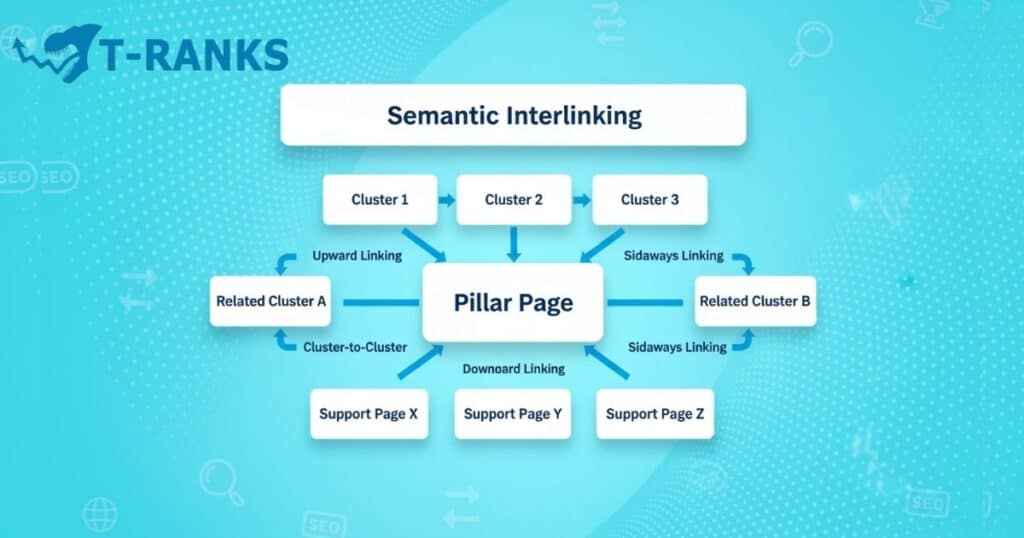
Once your pillar, cluster, and support pages are live, the next step is connecting them through internal links. These links are the invisible bridges that tell Google how your content relates and which pages carry the most authority. A good interlinking structure helps users navigate smoothly while helping search engines understand your site’s hierarchy and meaning.
Why Internal Linking Matters
Every page on your website has some degree of authority. Internal links act like votes that pass this authority from one page to another. When done correctly, they make your site easier to crawl, strengthen your topic relationships, and boost the visibility of your most important pages.
Think of it this way: your pillar page is the main hub, your clusters are the paths branching out from it, and your support pages are the small connecting streets that lead back. Without these bridges, Google can’t easily see the flow of context between your pages.
How to Build Strong Semantic Bridges
1. Link Upward: Every cluster page should link back to its pillar page. This tells Google which page is the main authority on that topic.
2. Link Sideways: Link related clusters or pages that share similar context or intent. For example, a page on Keyword Difficulty can link to Long-Tail Keyword Research because they belong to the same topic family.
3. Link Downward: From your pillar page, link to every major cluster and support page. This ensures users can explore the topic in depth and signals to Google that all these pages belong to one structured entity.
4. Use Descriptive Anchors: Avoid generic links like “click here.” Instead, use clear, keyword-context anchors such as Local SEO Checklist or Email Deliverability Guide. This helps both users and crawlers understand what’s behind the link.
5. Audit and Refresh Regularly: Over time, new content changes your map. Review your internal links every few months to make sure new pages are connected and outdated ones are removed.
Example
Imagine you have a pillar page on Technical SEO. It links to cluster pages like Core Web Vitals, Crawl Budget Optimization, and Structured Data Implementation. Each of those cluster pages links back to the pillar and also connects to each other where relevant — for example, Core Web Vitals linking to Page Speed Optimization. Together, they create a web of context that Google can easily follow and interpret as one complete topic.
T-RANKS Approach
At T-RANKS, we call this structure semantic interlinking — because it’s not just about links, it’s about meaning. Each link is placed intentionally to strengthen entity connections and guide both readers and algorithms through a logical knowledge path. Our internal linking audits ensure that every page contributes to your overall authority, not just your rankings.
How Schema and AEO Help Your Clusters Rank in AI Results
Building strong topical clusters isn’t just about writing high-quality content. It’s also about making your content easy for machines to understand. Schema markup and AEO (Answer Engine Optimization) are two powerful methods that help Google, Gemini, and other AI systems interpret the meaning, relationships, and structure of your pages.
When you use them correctly, your clusters have a higher chance of appearing in AI Overviews, featured snippets, and voice search results.
Schema Markup
Schema markup is a structured data format that helps search engines recognize the main entities, topics, and relationships in your content.
Instead of guessing what your page is about, Google can read it directly and categorize it correctly.
For topical clusters, schema markup helps you:
• Reinforce the main entity of each cluster, such as “Keyword Research,” “Local SEO,” or “Link Building.”
• Connect related topics across clusters, such as linking “Google Business Profile” with “Local SEO.”
• Enable rich results like FAQs, HowTo guides, and product listings that make your pages more visible.
Example:
If your cluster covers Keyword Research Tools, you can add:
FAQ Schema for questions like What is keyword difficulty?
HowTo Schema for tutorials such as How to Use AI for Keyword Research
SoftwareApplication Schema for pages comparing tools
These help your cluster communicate context clearly and stand out in AI-enhanced search results.
Answer Engine Optimization (AEO)
AEO focuses on optimizing content for AI systems and voice searches rather than just traditional search engines.
It’s about writing in a way that helps algorithms find direct, useful answers to user questions.
To optimize for AEO:
• Begin sections with short, clear answers before adding detail.
• Include FAQ boxes or question-based subheadings within your articles.
• Add co-mentions of related brands, tools, or concepts that reinforce topic relevance.
• Use concise summaries or small tables that AI systems can easily interpret.
Example:
If your cluster focuses on Local SEO Optimization, include micro-answers such as:
“Local SEO helps businesses improve their visibility in map and location-based searches.”
Then add FAQs like:
“How does Google decide local rankings?”
These clear, answer-driven structures increase your visibility in snippets and AI Overviews.
How Schema and AEO Work Together
Schema provides the technical framework of your content, while AEO gives it the semantic depth that AI systems rely on. Together, they make your pages both human-friendly and machine-readable.
Schema tells search engines what your content is about. AEO formatting tells them how it should be understood and displayed. Combined, they help your clusters appear more complete, accurate, and authoritative.
Example: A SaaS website with a pillar page on AI SEO Tools could include FAQ Schema for common questions, Review Schema for product comparisons, and short AEO-style summaries that highlight use cases and benefits. This creates a clean structure that Google can interpret easily and rewards with better visibility across AI and search features.
Competitive Coverage and Information Gain
Competitor analysis is one of the core steps in building a Topical Authority Map. You can’t decide your content direction, plan your backlinks, or even set your SEO priorities without understanding who your competitors are and what they’re already covering.
Competitors give you a roadmap of what works. They’ve already earned rankings and visibility for certain topics, and studying them helps you understand what kind of content structure, tone, and strategy Google is rewarding. At the same time, it reveals the gaps the areas where you can create better, deeper, and more useful resources to stand out.
1. Identify Your True Competitors
Start by searching your seed or cluster keyword on Google. The websites that consistently appear on the first page are your real SEO competitors — even if they are not your direct business rivals.
Ask yourself: Who ranks for this topic right now? Are they blogs, agencies, SaaS tools, or publishers? What kind of audience are they targeting — beginners, professionals, or technical readers?
Example: If your topic is Keyword Research Tools, you might find results from Ahrefs, Semrush, and Moz. You may also see sites like HubSpot or Backlinko, which focus on educational content. These are your content competitors — the ones holding your position in search.
2. Study Their Structure, Not Just Their Keywords
Keyword lists only tell part of the story. What truly matters is how competitors organize and present information. Google rewards clarity, depth, and content structure.
When reviewing their pages, look for: Headings and subheadings — what questions are they answering? Internal links — how are they connecting related topics? Visuals and data are they using examples, screenshots, or case studies?
Example: A competitor might explain How to Do Keyword Research but never mention AI-powered keyword clustering. That’s your opportunity to expand the topic and create something fresher and more complete.
3. Find the Gaps (Information Gain)
Information gain is about identifying what’s missing from current search results. It’s the value you add by offering new insights, examples, or explanations that others have overlooked.
To find these opportunities, check: People Also Ask boxes to see what extra questions Google shows. Related searches at the bottom of search results. Reddit, Quora, or forums where real users discuss their pain points.
Example: If you see no one talking about Keyword Mapping for YouTube or Entity-Based Keyword Research, those become new subtopics for your cluster. Filling these gaps helps Google recognize your content as original and valuable.
4. Turn Competitor Insights into Action
Use what you’ve learned to create a stronger, more complete cluster. Cover all the key topics that your competitors already rank for, but go one level deeper by adding missing elements, new data, or practical visuals.
Example: If competitors publish How to Find Keywords and Best Free Tools, you can expand your coverage with AI Keyword Clustering, Common Keyword Research Mistakes, or Keyword Mapping Templates. Each new piece should interlink with your pillar page and related clusters to show topical depth and completeness.
5. Key Takeaway
Competitor research isn’t copying what others do it’s learning what works, finding what’s missing, and building something better. When you analyze your competitors’ content before creating your own, you move from guessing to strategizing. That’s how you achieve information gain the key factor Google uses to identify content that’s not just relevant, but authoritative and uniquely valuable.
Measuring Authority Signals — On Your Site and Beyond
Once your Topical Authority Map is live, the next step is to measure how well it performs both inside your website and across the wider web. Authority isn’t built by publishing alone. It grows through consistent topical coverage, user engagement, and the signals your content earns in AI systems, forums, and real-world discussions.
Cluster Health: Tracking Your Internal Progress
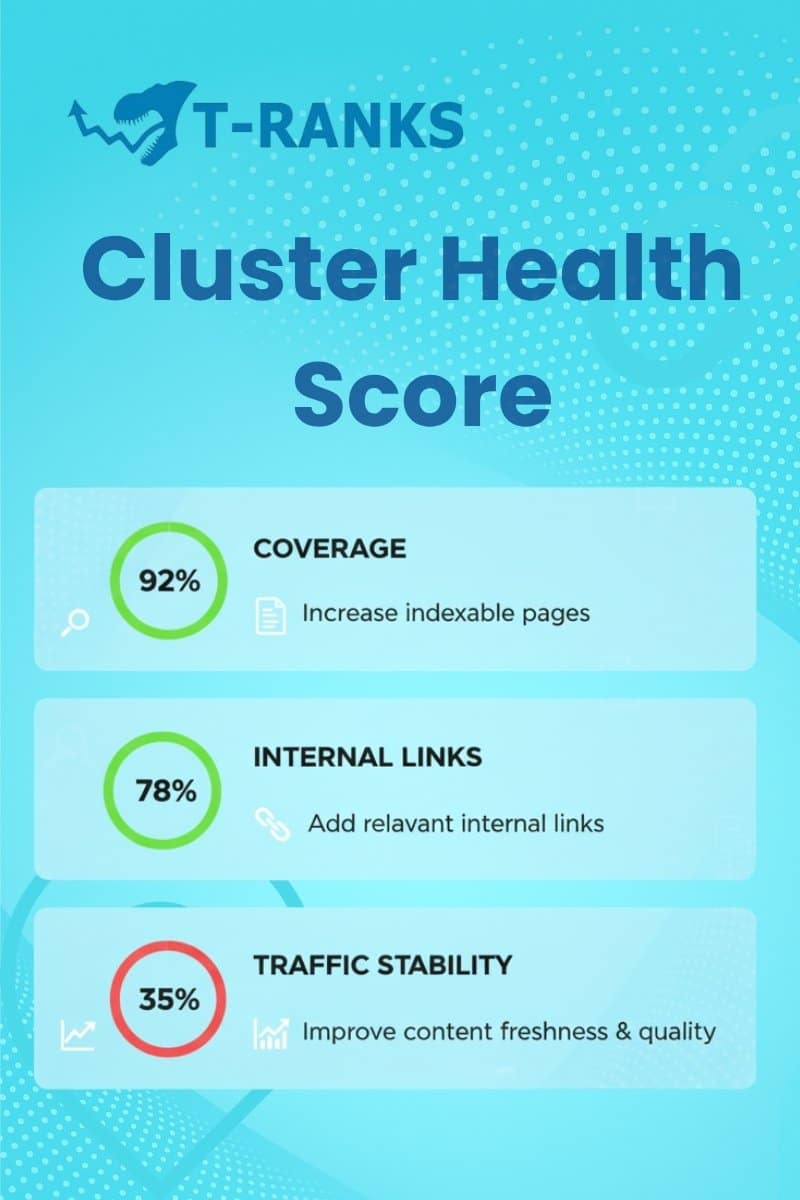
Think of each content cluster as a small ecosystem. It should fully cover one topic from every important angle — definitions, tools, FAQs, and examples. Cluster Health measures how complete and connected that ecosystem really is.
To check your cluster health, review:
- Content coverage: Have you published all planned subtopics?
- Internal links: Are your pillar, cluster, and support pages linked correctly?
- Traffic stability: Are all pages still attracting consistent visits and engagement?
Example: If your Technical SEO cluster includes ten planned pages but only eight are published, your cluster is 80 percent complete. Those missing topics — such as Log File Analysis or Page Experience Metrics 2026 become your next content priorities.
A healthy cluster isn’t just one that ranks well; it’s one that stays connected, updated, and continuously growing.
PPR Movement: Tracking Growth Over Time
As your site expands, monitor how each page performs through the lens of Prominence, Popularity, and Relevance (PPR). These three metrics show whether your authority is actually increasing.
- Prominence: Are your core pages ranking for broader, higher-value terms?
- Popularity: Are your pages attracting backlinks or mentions from trusted sites?
- Relevance: Are your articles aligning with the right search intent and user needs?
A steady upward movement in these areas means your topical map is maturing — you’re not just publishing content, you’re building recognition.
External Signals: Community Mentions and AEO Recognition
Authority doesn’t stop on your own domain. Search engines and AI systems also monitor how your brand and resources appear in real conversations across the web. When people mention your content on Reddit, Quora, or niche forums, these natural references act as co-mention signals that strengthen your entity association and trust.
Example: Someone in a Reddit discussion writes, “We used the checklist from T-Ranks to fix our Core Web Vitals.” That simple statement tells AI systems like Google’s AI Overviews or Perplexity that your advice is genuinely helpful and trusted by users a signal of true authority beyond backlinks.
The best way to earn such mentions is by helping first. Join relevant discussions, answer real questions, and share insights that solve problems before you ever promote your content.
AI Visibility: Recognition Beyond Traditional Rankings
In today’s AI-driven search environment, being visible in Google’s top ten results is only part of the picture. Systems like Gemini, Perplexity, and AI Overviews analyze web data to generate direct answers. When these systems cite your brand, mention your dataset, or quote your examples, it means your content is recognized as a reliable part of the web’s knowledge layer.
Example: If an AI Overview cites a line like “According to T-Ranks’ 2026 SEO dataset…”, it’s proof that your content has reached the highest level of credibility . it’s being used as a trusted source in automated summaries.
Final Takeaway
Measuring authority isn’t just about checking rankings or counting links. It’s about understanding how your content performs internally through structure and coverage, and how it’s recognized externally through mentions, citations, and AI visibility. When both of these signals grow together, your topical authority becomes something no algorithm update can easily replace.
PPR Movement — Tracking Position, Performance & Relevance
To understand how your clusters evolve over time, track your PPR Movement — short for Position, Performance, and Relevance. These three pillars show you not just how well you rank, but how meaningful your presence is.
- Position: Where your pages rank for key terms. If your “Core Web Vitals” pillar moves from position 12 to 5, it’s a sign your authority is growing.
- Performance: How well your content engages users. Are people reading longer, clicking deeper, or converting into leads? Strong engagement tells Google your content satisfies intent.
- Relevance: How often your brand or content gets mentioned in AI systems, social discussions, or forums. If you stop appearing in AI summaries or Reddit conversations, your topical relevance might be fading — time to refresh your examples and insights.
For example
Imagine your Core Web Vitals page still ranks well, but Perplexity and Gemini have stopped mentioning it. That’s a signal to update the article with new data, visuals, or stats so it remains current and authoritative. When you track PPR, you’re not just watching rankings you’re watching how your authority grows across every surface, from organic search to AI-driven visibility.
From Topical Map to Site Knowledge Graph
A Topical Authority Map shows how your content connects but a Site Knowledge Graph shows how your entities connect. It’s the next level of organization where you’re not just linking pages together, you’re building a network of meaning that both users and search engines can understand.
Think of it as moving from a map of topics to a web of concepts, entities, and relationships — exactly how Google’s own Knowledge Graph interprets information across the internet.
1. From Topics to Entities
When you build your topical map, you focus on keywords, pages, and clusters. When you evolve that map into a knowledge graph, you start focusing on entities , the specific people, places, tools, or concepts that define your niche.
Each entity has attributes (details) and relationships (connections to other entities). By clearly identifying these in your content, you help search engines form an accurate picture of who you are, what you do, and how your pages connect semantically.
Example: In a topical map for Local SEO, your seed topic might include clusters like Google Business Profile Optimization and Citation Management. In a site knowledge graph, these become entities connected like this:
Local SEO → Google Business Profile → NAP Consistency → Citation Platforms → Local Ranking Factors.
Each node (page) is linked not just by text but by context.
2. Why Knowledge Graphs Strengthen Authority
Search engines and AI systems like Gemini, Perplexity, and ChatGPT increasingly rely on entity-based understanding, not just keyword matching. When your site reflects clear relationships between entities, it sends signals of expertise, consistency, and topical depth — key parts of E-E-A-T and long-term visibility.
This structured clarity helps in three main ways:
- Faster recognition: Google can immediately associate your brand with a defined topic or category.
- Higher trust: When your site’s entity graph aligns with known public data (e.g., Wikidata, schema.org), your credibility increases.
- AI readiness: AI systems reference your structured content more easily in summaries, snippets, and citations.
3. Building Your Site Knowledge Graph

You don’t need advanced coding or custom tools to begin — you just need structured organization and consistency.
Here’s a practical roadmap:
Step 1: Identify Core Entities List the main subjects, tools, people, and brands mentioned throughout your site. Example: Keyword Research, Core Web Vitals, Schema Markup, T-Ranks.
Step 2: Define Relationships Decide how these entities connect logically. Example: T-Ranks → offers → PBN Link Services → improve → SEO Rankings.
Step 3: Reflect Relationships in Your Content Use internal links, consistent headings, and schema markup to show these connections clearly.
Step 4: Add Structured Data (Schema) Apply schema types like Organization, Person, Product, HowTo, and FAQ to formalize these relationships. This creates the technical framework that helps search engines recognize your site’s internal knowledge structure.
Step 5: Validate and Iterate Use tools like Google’s Rich Results Test or Knowledge Graph Search API to check which entities Google already associates with your brand. Update content regularly to strengthen weak connections.
4. Example in Practice
Let’s say you manage a SaaS-focused SEO site. Your topical map covers subjects like:
- SaaS Link Building
- Content Strategy for Startups
- Authority Metrics and DR Scores
When converted into a knowledge graph, these become structured relationships:
Entity: SaaS Link Building Connected To:
- “T-Ranks” (organization offering the service)
- “DR Metrics” (measurement attribute)
- “Guest Posting” (related tactic)
- “Google Ranking Factors” (parent concept)
This interconnected context tells Google:
“T-Ranks is an expert entity in SaaS link building, which is part of the larger domain of SEO and ranking strategies.”
That’s how search systems move from reading pages to understanding entities — and that’s how real authority is established.
5. The Key Takeaway
A Topical Map organizes your content for humans. A Knowledge Graph organizes your meaning for machines. When both align your clusters, schema, and entities , you create a self-reinforcing structure that keeps earning trust, citations, and visibility long after publication.
In 2026 and beyond, authority isn’t just about writing around keywords , it’s about building an ecosystem of interconnected entities that machines can understand and users can trust.
Conclusion
In conclusion, building topical authority is about creating structured connections between ideas, not just publishing more content. It begins with identifying clear seed topics, expands through organized clusters, and matures into a complete system of interlinked entities that both users and search engines can understand. When your internal structure, schema, and external mentions align, your site evolves from a simple collection of articles into a knowledge network that earns trust and visibility over time.
Consistency, clarity, and relevance are what sustain authority , every update, link, and optimization reinforces the signals that define expertise. Focus on depth instead of volume, clarity instead of complexity, and value instead of noise.
Ready to turn your content into a trusted authority network? Start mapping your topics today and build a structure that grows stronger with every new piece you publish
Start mapping your topics today and build a structure that grows stronger with every new piece you publish.
T-RANKS can help you build scalable topical maps and entity clusters.
1. What is a Topical Authority Map?
A Topical Authority Map is a strategic blueprint that organizes your website’s content around related topics and entities not just keywords. It shows how pillar and cluster pages connect to cover a subject completely, helping search engines and AI systems understand your expertise.
2. How is a Topical Map different from a Site Map?
A Topical Map structures your content based on meaning, relationships, and intent guiding your internal linking and strategy. A Site Map simply lists URLs to help crawlers find pages. In short, the Topical Map helps people and AI understand your topics; the Site Map helps bots discover your pages.
3. Why does a Topical Authority Map matter for SEO?
It helps you rank across entire topic groups instead of single keywords. By showing Google and AI systems how your pages connect semantically, you strengthen E-E-A-T signals, improve internal link flow, and increase visibility in AI Overviews (AIO).
4. How do I choose the right seed topic?
Pick a seed topic that’s broad enough to support 3–5 clusters but focused enough to build real authority. Example: Email Marketing is ideal — Marketing is too broad, and Email Subject Lines is too narrow.
5. What’s the difference between a pillar and a cluster page?
A pillar page is your main, comprehensive guide on a topic. Cluster pages are supporting articles that go deeper into related subtopics. Together, they create a web of context that boosts topical depth and passes link equity effectively.
6. How big should each cluster be?
Aim for 6–12 well-linked pages per cluster. That’s usually enough to cover a topic completely without overlap or dilution.
7. What is PPR, and how does it differ from Keyword Difficulty?
PPR (Prominence × Popularity × Relevance) measures how well a topic fits your authority map and link potential. Keyword Difficulty only measures competition. PPR helps prioritize topics that are easier to win and more valuable for strengthening your topical graph.
8. Do I need a Knowledge Graph to build a Topical Map?
No. You can start with a simple spreadsheet or diagram. A Knowledge Graph is just the advanced version , it connects your topics, people, and products using structured data for AI understanding.
9. How can I find missing topics or entities?
Compare your content to top-ranking competitors using entity extraction tools like InLinks, Google NLP, or SurferSEO. If they mention entities or subtopics you don’t, those are your content gaps , perfect opportunities to expand coverage.
10. How do I know if a topic is AI Overview–friendly?
Search your topic and observe if Google shows AI Overviews, People Also Ask boxes, or video/image snippets. If you see multiple formats, the topic likely has strong AEO (Answer Engine Optimization) potential.
11. How often should I refresh pillar pages?
Update major pillar pages every 60–90 days, or after key industry updates. Fresh data, visuals, and FAQs signal “living authority,” which helps your pages maintain rankings and visibility in AI panels.
12. Can I reuse my old content silos to build a Topical Map?
Yes, partially. Traditional silos organize content hierarchically, while Topical Maps organize by semantic relevance. You can reuse strong hubs but should rebuild internal links and intent alignment to fit entity-based clusters.
13. Can programmatic pages fit inside clusters?
Yes — but only if they add unique value (for example, location, year, or feature-based pages). Avoid purely templated or repetitive content. Each page should include distinct data or context to prevent thin-content penalties.
14. How can I measure the performance of my clusters?
Use dashboards like Looker Studio or Ahrefs to track:
Cluster-level traffic and keyword coverage
Internal link growth and engagement
AI Overview mentions and entity coverage These metrics show which clusters are performing well and which need optimization.
15. What’s a realistic 90-day result after launching a Topical Map?
Expect stronger topical visibility, around 60% cluster coverage, higher click-through rates, and the first signs of AI Overview or Discover mentions within 2–3 months , provided your content is consistent, connected, and well-structured.
